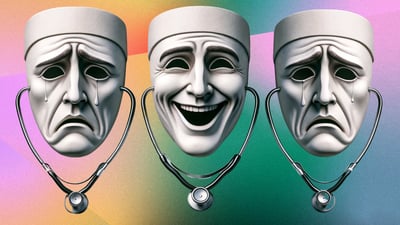In a November 9 podcast interview with Becker's Review, Sarah Poncelet, Mayo's Executive Director of Strategy Development, announced the renowned clinic's new strategy: to scale automation across Mayo's 3 campuses to reduce pressures on areas with critical staff shortages or that are experiencing high turnover:
"Thirty percent of healthcare has the potential for automation, so we really want to reduce administrative burden, reduce manual tasks and processes in order to free up our most valuable asset, which is our people, and make sure they're doing human-related tasks versus things that could be potentially automated." Ms. Poncelet says she and her team seek to "bring joy back" to care teams and improve outcomes, safety and patient experience."
A noble goal indeed.
Eliminate 30% of the tasks that are not human-related to "bring joy back".
Wait a minute
.. let's conduct a thought experiment here
and test out this A.I. utopian future before we dive right in.
IMAGINE ...
It is January 2025. Another 100,000 boomer physicians have retired in 2024. However, miracle of miracles, Mayo has come through on their 2023 goals and successfully A.I. automated 85% of all documentation tasks.
- EMR - there's a bot for that.
- Answering questions from staff or messages from patients and families - there's a bot for that.
- All the other quality/safety alerts and InBox tasks ... yup, bot for that too.
All you have to do is just see patients. (hear the angels singing?)
QUESTION:
How many patients?
In this documentation-free environment, what is your new visit volume / RVU quota?
If you look back at the beginning of this post, notice how you were assuming you would be 30% less busy than you are right now, once the automation improvements are complete.
You would be seeing the same number of patients, while A.I. took away those pesky 30% of your time wasted on non human-related tasks.
You KNOW THAT IS NOT TRUE, RIGHT?
Nope. 30% less documentation will translate immediately to 30% more patient volume.
Notice we are creating a whole new set of overload problems that will give us a whole new burnout threshold in 2026.
Here are a few of the issues I can imagine will bite physicians and staff in this new reality.
1) All the Fatigues
If you speed up the pace of patient encounters, you will fatigue the physician faculties that are involved in patient care. The drain will be much higher than it is now.
We know and understand a number of these fatigue-able, doctor-specific "human-related" factors.
- Decision fatigue
- Compassion fatigue
- The sheer cognitive overload of a 40 patient office day or caring for 26 as a hospitalist. Back-to-back-to-back patient interviews, especially in primary care is literally trying to drink from a fire hose.
If you are a patient - you will want to have an AM appointment for sure.
I am suspicious that this new reality will violate the limits of stamina for the doctors and staff on a daily basis. The physicians and staff will collapse, completely wrung out before the shift is over, unless we give them all "special pills" like the military does on the battle field.
2) Massive boost to virtual
You can't consistently shove 40 patients a day through meaningful face-to-face encounters in even the most advanced office designs ... unless we limit the patient contact to urgent care issues. Virtual visits will need to be liberally mixed in or scheduled in blocks in the doctor's week. In many cases I suspect face-to-face will be completely abandoned because of the time and motion friction of seeing patients in the flesh and blood.
And we already know the impact of the compromises of virtual care.
3) The end of human triage
Bots will handle all first contacts from any source except an emergency patient brought by ambulance to the ER with lights and sirens. And I bet you won't just be able to shout REPRESENTATIVE to get a live agent.
And the thought that all of this will BRING JOY BACK to the physicians and staff is Pollyanna, rose colored glasses, short-term thinking.
The documentation-free, touch-free, human-free future of healthcare will come with its own set of unique stressors - things you and I can only speculate about as we sit here on the front porch of this epic metamorphosis of healthcare.
I am certain that more joy and wellbeing and a lowering of burnout are not guaranteed by any means.

============
PLEASE LEAVE A COMMENT
What do you think the documentation-free healthcare workplace of the near future will look and feel like?



